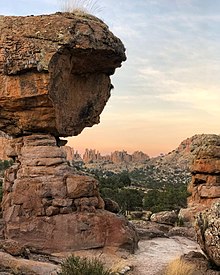Sierra de Organos National Park (Parque Nacional Sierra de Órganos) is a scenic park with hundreds of unusual rock formations in the states of Zacatecas and Durango, Mexico. The park territory is about evenly split between the two states, but most visitors enter via Sombrerete in Zacatecas. It is an enchanting and surreal landscape reminiscent of some of the U.S. national parks near Moab, Utah.

Understand
[edit]The park is big, covering an area of 1,125 hectares, but it's lightly visited and you will often feel like you are the only person within miles.

Landscape
[edit]The park is often described as looking like a set from a western movie, and for good reason. Countless movies were filmed in the park, capitalizing on the wide open spaces and the impressive rock formations carved over thousands of years through the processes of wind and erosion. Most of the movies were made during the period between 1950 and 1979. The park gets its name from the number of formations that resemble the array of pipes on a pipe organ. Some locals say its because there are so many formations that resemble male sex organs. There are quite a few formations that resemble animals or common objects, one that looks like the crows nest perched atop the mast of an old sailing ship. There are several small mesas in the park.
The park is situated in an area of the Sierra Madre Occidental mountain range that is considered a high plain. The highest point in the park is 2,560 meters.
Flora and fauna
[edit]Plant life varies depending on whether you are on the rocky, windswept, desert plains, or whether you are up in the mountains in the cooler forests. The forests are mostly pine and juniper with a type of oak known as encino. The rocky arid lands have desert shrubs, palms, maguey, and cacti, particularly nopal. Rocky areas of the park often have stands of pinyon pine.
Several species of mammal make their home in Sierra de Organos, with cougars, red lynx, and coyotes filling the role of apex predators hunting a range of prey that might include collared peccary when they're hungry for a pork dinner, but more commonly, rabbits, squirrels, raccoons, opossum, badgers, white-tail deer and gray foxes. Two endangered mammals that live in the park are the cacomixtle (a type of ringtail) and the kit fox.
History
[edit]The park was created in 2000 by decree of President Vicente Fox.
Climate
[edit]Sierra de Organos is a semi-dry climate where daytime temperatures are warm in the winter and hot in the summer and nighttime low temperatures are cool in summer and can be downright cold in winter. Summer is the rainy season and occasional severe thunderstorms are possible.
Get in
[edit]From Sombrerete, head northwest on federal highway MEX 45 for 30 km, then turn right onto the park access road.
The park is accessed via a dirt road that is regularly maintained, though some stretches may be seasonally difficult. Although a 4x4 truck is the most suitable vehicle for use in the park, a regular car will not have any problem getting to the park itself, you might need to slow down and dodge some potholes in places.
Fees and permits
[edit]Park admission is M$25 per person, per day. Camping is M$50 per person, per night. Fees are paid at the park office, where you can also get information about local conditions and hire a guide if you want a local to take you on hikes or ride with you to show you the sights (and how to access backcountry areas of the park).
Get around
[edit]Mountain biking is the best way to get around the park, or hike the many trails. A 4x4 truck is useful for exploring further reaches of the park.
See
[edit]Do
[edit]- Hike: The park has miles of marked trails, most of which cover easy terrain without a lot of elevation changes. It is an excellent park to explore by foot and no special skill or stamina is needed. If you want more challenging trails there are longer routes as well as those that require a bit of climbing skill.
- Mountain biking is a fun way to explore the park, and it's much more environmentally sensitive than using a 4x4 truck in the backcountry
Eat
[edit]Bring what you want to eat. There are no restaurants in the park. The nearest restaurants are in the town of Sombrerete.
Drink
[edit]Bring water. Water sources are available in the park, but trust them at your own peril.
Sleep
[edit]Lodging
[edit]Cabins are available for rent in the park. Inquire at the park entrance. Do not expect fancy accommodations, they cost about M$700 per night (Feb 2023). The cabins are minimally equipped with cots, a kitchen (with electric stove) and an outdoor grill, but no bedding is provided and no kitchen utensils. Bring sleeping bags or sheets and pillows, as well as all the drinking water and food that you'll need for how ever many days and nights you plan to stay.
Camping
[edit]A camping area is available, including RV sites. Bathrooms are pit toilets.
Backcountry
[edit]Stay safe
[edit]- Dress for the weather - bright sunshine is always likely, so wear a hat. Winter temperatures can get cold, particularly at higher elevations, so a warm jacket, or at least a sweater and windbreaker, is a good idea.
- Wear boots - the terrain is rocky and there are a lot of formations covered in bird guano

